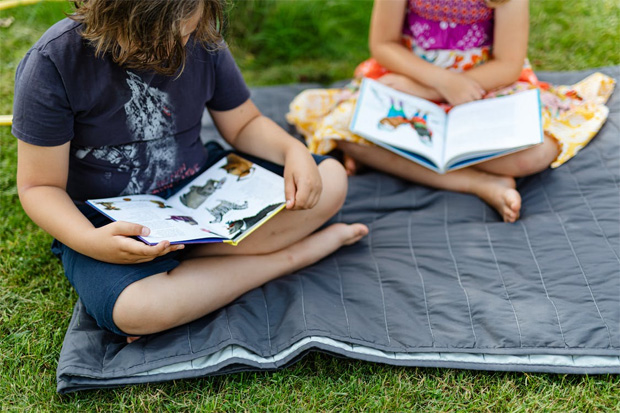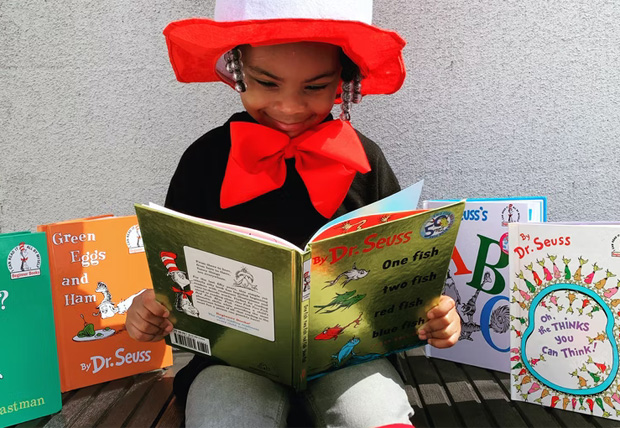Awesome Literary Projects That Will Keep Children Reading This Summer

Awesome Literary Projects That Will Keep Children Reading This Summer
The summer holidays are here. Summertime is of course for relaxing, having fun, and enjoying a break from the usual academic calendar. Still, it’s also important to keep young minds engaged through these months away from school. If you are wondering how to keep children reading this summer, you have come to the right place.
Getting children to read over the school holidays will help to ensure they continue to learn while also having fun. Below, you’ll find ten interesting summer reading projects that will entertain kids and stimulate their brains. These ideas vary from planning themed reading days to designing reading challenges and more. All the projects are aimed at inspiring a love of reading in children of all ages. We will also discuss how creating a booklet may be a creative way to inspire children to read. Let’s get started!

11 Literary Projects for Children
1. Design a Summer Reading Challenge
Setting up a challenge is a great way to keep children motivated. This summer, set up a reading challenge to keep the kids interested in books. This exercise will encourage consistent reading and also offers an exciting and successful sensation.
How to Design a Reading Challenge for your Kids
Establishing a summer reading challenge is easy and can be adapted to your child’s age and reading ability. First, define specific, reasonable objectives. These could be determined by daily or weekly book, page, or reading minute counts – whichever you think would work best for your child. While older children could, for example, aim to read three chapter books during the summer holidays, younger children might set a goal of reading 10 picture books.
Ideas for Objectives and Awards
To inspire children, goals should be demanding but reasonable. Here are some ideas:
- Read for 15 minutes every day
- By the end of summer, aim to have read 5 novels
- Explore 3 new genres of books
Incentives help to make the challenge more interesting. The can simple, small rewards such as more playtime, fun stickers, or a small toy or more major incentives like a day out, a new book, or a special outing.
Advice for Parents on Maintaining Children’s Motivation
Use a reading notebook or chart to track your child’s reading (the amount of books or time). For young children, something visual is usually the best option and can be very inspiring for them.
To help with motivation, you can also involve friends in the challenge. Inviting friends to participate is a great way to foster friendliness and community as well as fierce competitiveness.
Also celebrate smaller milestones along the way to keep your child’s enthusiasm along the way.

2. Design a Dedicated Reading Area
Designing a dedicated reading area for your child to use is a great way to enhance their encouragement and to turn reading into a loving hobby.
The Value of a Dedicated Reading Space
A specific reading area offers a peaceful and calm surrounding suitable for reading. This place provides children with a relaxing environment to use to truly get stuck into enjoying their books without other distractions.
Ideas for Arranging a Cosy and Inviting Space for Reading
Creating a reading nook doesn’t have to be expensive or elaborate. Below you can browse some simple but powerful ideas for creating a reading space for your child:
- Create cosy seating with bean bags, pillows, or a small sofa or armchair.
- Ensure there’s plenty of natural light or install a nice reading lamp.
- Keep books within reach so that your child can select books independently.
- Let children choose details such as colours and artwork for their reading area.
Get Children Involved in the Process
Get your child involved in the process of creating their reading nook. This will help them get excited and enthusiastic. Allow them to make decisions about the space – the décor, what books to display, etc. This participation not only makes the area more personal to your child but also raises their passion for utilising it. Having a comfortable dedicated reading space is sure to encourage your child to grab a book and get reading.

3. Start a Book Club
Starting a book club is an excellent approach to turn reading into a social and involved hobby for children and adults alike. It lets children talk books, exchange ideas, and find new tales to explore together.
Advantages of a Children’s Book Club
There are many things that young readers may gain from a book club:
- Talking about books allows children to grasp the content better.
- The social interaction of the book club fosters cooperation and social skills.
- Knowing they will share their ideas with their friends helps children to become more focused readers.
How to Organise a Children’s Book Clube
Starting a kids’ book club can be easy and enjoyable too. Follow the below steps to get started:
- Invite some friends or neighbours of a similar age and reading ability to your child.
- Let members flip around selecting books to guarantee a range of genres and subjects.
- Decide on a regular meeting schedule, perhaps weekly or bi-weekly.
- Create open-ended questions to help to spark conversation. Urge children to share their ideas and to pay attention to others.
Recommended Books and Thought Questions
Selecting interesting, age-appropriate literature is really vital for a successful children’s book club. These are a few ideas:
- Young Children: Maurice Sendak’s “Where the Wild Things Are” – What, in your opinion, Max gained from his trip?
- Middle Grade: E.B. White’s “Charlotte’s Web” – Over the narrative, how do the characters exhibit friendship?
- Older Kids: J.K. Rowling’s “Harry Potter and the Philosopher’s Stone” – For what reasons Harry qualifies as a hero?
Starting a book club is likely to turn reading into a pleasant, group activity that also builds a greater love of literature.

4. Have Themed Reading Days
Themed reading days is a great way to add some newness and inventiveness to summer reading. It’s a great way to explore a range of genres and subjects. Choose a new theme for each day and watch how reading is transformed from a passive exercise into an active one.
Themed Reading Days: An Explanation
By having themed reading days, children can choose certain topics for every day of the week. This will motivate them to read books on those subjects. This strategy is a great way to keep reading interesting and fresh. Children are sure to eagerly await what each new day will bring.
Here are a few examples of themes and topics ideas to get you started:
- Mysterious Mondays: Explore mystery and detective tales.
- Travel Tuesdays: Read books set in different countries and cultures.
- Wildlife Wednesdays: Learn about nature and animals.
- Throwback Thursdays: Savour historical fiction or classic works.
- Fantastic Adventures Fridays: Dive into fantastic adventures and exotic realms.
- Science Fiction Saturdays: Discover books about science fiction.
- Tales & Stories Sundays: Share your favourite tales with your family
Getting Children to Choose Their Own Themes
Giving kids the ability to select their own topics will help to make the exercise much more interesting for them. Encourage them to choose books that are relevant to their hobbies and also to explore some topics or subjects that they might not normally gravitate to.
Themed reading days help make each day’s reading special and unforgettable, guaranteeing that reading stays fun and fascinating.

5. Design Your Own Booklet
Designing and making your own booklets can be a fun approach for children to engage with the tales they read and to express their imagination. This is a great summer project that combines reading, writing, illustration and design.
There are many advantages of designing pamphlets with your kids to support reading. Below are a few of them:
- Summarising and visualising tales helps to strengthen knowledge.
- Children’s creative expression lets them use their artistic talents and creativity.
- Completing a booklet project provides children with a sense of pride.
- The booklet will become a lovely keepsake to remember the fun project.
Techniques for Making a Booklet
Here are some easy steps to follow to produce your own booklet:
- Choose a Book: Ask your child to choose their favourite book or tale from previously read literature.
- Plan the Content: Talk about the story’s major components—that of the storyline, characters, and location. Choose for every page of the booklet what will be featured.
- Get Supplies: Get paper, coloured pencils, markers, and any other creative tools your youngster may need.
- Design the Pages: Help your child break out the narrative into chunks and design a page for every piece. They may summarise the material and also provide images to go with it.
- Bind the Booklet: Once every page is finished, staple them together or bind the booklet with a hole punch and ribbon.
Older children might enjoy going down the graphic design route and creating their booklet digitally. You can even have it printed by a printing company.
Concepts for Booklet Topics
Explore many topics for your booklets to keep things interesting:
- Write in a journal from the viewpoint of a story’s character.
- Create and show different endings in your writing.
- Create fact books condensing the main ideas for non-fiction works.
- Explore the distribution and exhibition of books
Encourage your child to show their booklet creation to their friends and relatives. You can do this with a little presentation when you have visitors. Also set up a space in your home library where you child can keep the booklets that they’ve created. For family and friends who are far away, take pictures or scan the booklets for them.
Making booklets gives your kid a fun and creative release and a feeling of success in addition to improving their grasp of the books they read.

6. Participate in Creative Book-Related Activities
Another great way to help your child connect more with literature while also boosting their creativity is to combine reading with artistic pursuits. It’s also a great way to encourage children to think beyond the book and to bring stories to life.
Book Inspired Arts & Crafts
Book inspired creative endeavours can be entertaining as well as instructive. Below are some fun ideas:
- Book-themed Crafts: Create artwork or crafts inspired by book characters or settings from stories. You can make dioramas of important events or make masks of beloved characters for example.
- Tale Maps: Show children the scene of the tale by drawing maps of it together.
- Favourite Parts: Challenge children to show their favourite scenes from the book in a drawing or painting.

7. Compose Book Reviews and Summaries
Book evaluations and summaries are a great way to help children to communicate their opinions and ideas about what they have read. Additionally, it also helps them to understand what they have read.
For reviews, guide children to create brief evaluations including their likes and dislikes of a book that they’ve read as well as their reasons for recommendation.
For summaries, encourage children to focus on important story aspects and characters and to summarise the narrative in their won words.
You can also create your own mini books or booklets with your child’s drawings, their comments, and summaries. This is a great way to inspire children to create and depict their own tales, therefore developing their writing abilities. It’s also an artistic activity that children are sure to enjoy.

8. Visit Your Local Library
Visiting your neighbourhood library is another great way to keep kids interested in reading during the summer and beyond. Libraries provide an excellent selection of books of course as well as a plethora of tools and events that help make reading more fun and approachable.
Benefits of Frequent Library Visits
There are many advantages of frequent library visits for young readers. Here are a few examples:
- Libraries always have something fresh and new to read within their large collection of books.
- Many libraries provide summer reading activities (that sometimes include prizes) and events designed to encourage a love of reading.
- Libraries also provide a peaceful and cosy setting to enjoy your books and for studying too.
How to Make Trips to Libraries Exciting
Turning library trips into an exciting journey can help inspire a passion for reading. Here are a few ideas for making the library trips even more fun:
- Create a list of things your child can search for, like a book by a certain author or genre.
- Create a bingo card with varying reading tasks (e.g., read a book with a blue cover, a graphic novel).
- Author Spotlights: Work through the works of a chosen author together.
Attend Library Activities and Events Together
Often, libraries have a range of activities and events meant to further involve young people and encourage them to read. There are often extra events during the school holidays. Here are a few examples of library activities and events that might be available at your local library:
- Storytime events – librarians read books to a group of children.
- Library craft workshops – work on projects connected to literature or topics in craft workshops.
- Reading challenges – join library-organised reading challenges to inspire children to read more.
Making the most of what libraries have to offer can help enhance your child’s summer reading experience.

9. Use Technology for Leisure Reading
Technology is an important part of modern life and can also be used as a tool to make reading more interesting and participatory for children. From interactive e-books to instructional applications, there are various ways to use technology into summer reading projects.
Websites and Apps for Education
There are many applications and websites intended to make reading enjoyable and instructive feature:
- Epic: A large digital collection including kid-friendly instructional videos, books, and audiobooks.
- Interactive courses and activities designed to improve reading proficiency.
- Celebrity readers of children’s books help to bring tales to life online.
- Kindle Kids: An e-reader designed for kids with access to thousands of books. You can install the Kindle app on your smartphone or tablet too without having to have an actual Kindle device.
Interactive Books and Internet Resources
By increasing engagement, interactive e-books and online resources may improve the reading experience. Many e-books have interactive components, animations, sound effects, and other tools meant to enthrall younger readers.
Websites like Goodreads include child areas where users may post book suggestions, participate in conversations, and exchange reviews.
How to Manage Traditional Reading Time with Screen Time
Although technology has numerous advantages, to guarantee a well-rounded reading experience it’s crucial to balance screen time with traditional reading. Here are a few ideas to help achieve this:
- Screen time rules: Set explicit rules on the amount of time your child can spend reading actual books vs viewing screens.
- Encourage a combination: Kids should be encouraged to read a combination of digital and physical literature. They may, for instance, read a real book at home and an e-book on a plane.
- Talk about it: Encourage children to talk about what they read—online and in print—to help them to develop critical thinking and understanding.
By smart use of technology, reading may become more dynamic and fun, keeping children captivated with books all summer.

10. Organise Reading-Based Events
Organising reading-themed activities will give summer reading a social and festive touch that children will love. These could be anything from small family get-togethers to more major community celebrations.
Concepts for Events and Parties Inspired by Reading
Below are some great ideas for organising events with a reading theme:
- Dress Up! Plan a gathering when children dress as their favourite literary characters. Add events including games with a character theme and a costume procession.
- Organise a Storytime Picnic. Everyone brings a book to read and distribute. Set aside time for an adult to read out loud to the children.
- Reading Camp. Setup blankets or tents in the backyard for a reading campout. Add s’mores for snacks and flashlights for reading beneath the stars.
Literary-Based Games and Activities to Enjoy
To make these events even more fun and interactive, include games and activities help to make reading sessions:
- Bingo Cards: Create bingo cards with various reading-related activities (such as complete a mystery novel or read a poem).
- Scavenger Hunt: Plan a scavenger hunt wherein children locate objects or solve hints connected to a certain book or tale.
- Read Aloud: Teams alternately read aloud from a book, passing it around like a baton in a reading relay race.
Engaging Friends and Family
Including friends and relatives will improve the summer reading experience for children too. Here are a few ideas for smaller events to consider:
- Book Swap: Plan a book swap wherein children trade books they have read with others.
- Family Reading Nights: Set aside one evening a week for family reading nights when everyone reads together and talks about their books.
- Community Read: Plan community activities wherein groups of children have volunteers read aloud.
Reading-themed events help you to create unforgettable moments honouring books and encouraging a love of reading.

11. Combining Writing and Reading
Writing and reading are natural companions. Linking the two will enable kids to enhance their critical thinking and understanding. A few simple ideas include:
- Encourage children to develop tales with their favourite characters or to write other endings to the novels they read.
- Encourage children to keep a notebook in which they record their ideas and emotions regarding what they have read.
Exercises and Writing Prompts
You can also include fun writing exercises which can inspire your child’s imagination and transform writing into a pleasurable hobby:
- Imagine What If? Encourage children to create new stories based on “What if?” questions about their favourite novels (e.g., “What if Harry Potter went to a different school?”).
- Write Letters. Encourage children to write letters to their favourite book characters or writers.
- Create Rhymes. Encourage children to create rhymes or poetry on book topics or characters.
Create a Family Newsletter or Storybook
Projects involving cooperative writing may span a lifetime and can include the whole family producing mementos. Here are a couple ideas:
- Every family member may help create a monthly newsletter with book reviews, anecdotes, or artwork.
- Work together to create and draw a family tale project. Everybody may create a chapter or highlight various tale points of view.
Including creative writing into your summertime activities can improve your child’s reading experience and also provide a useful creative outlet.

Awesome Literary Projects That Will Keep Children Reading This Summer – Conclusion
Summer is a great season to inspire children to keep their brains active and explore the world of books. Including these 11 interesting reading exercises can help children have a lively and entertaining reading experience this summer.
From organising book clubs and themed reading days to designing comfortable reading areas and putting up reading challenges, every activity presents a different approach to make reading an exciting journey. Regular library trips, innovative book-related crafts, and interactive e-books and audiobooks provide variation and depth. Using technology and organising reading-oriented activities helps to improve children’s involvement even further.
Start these projects designed to keep children reading this summer today and see how much your child really enjoys reading and learning!
Collaboration.




